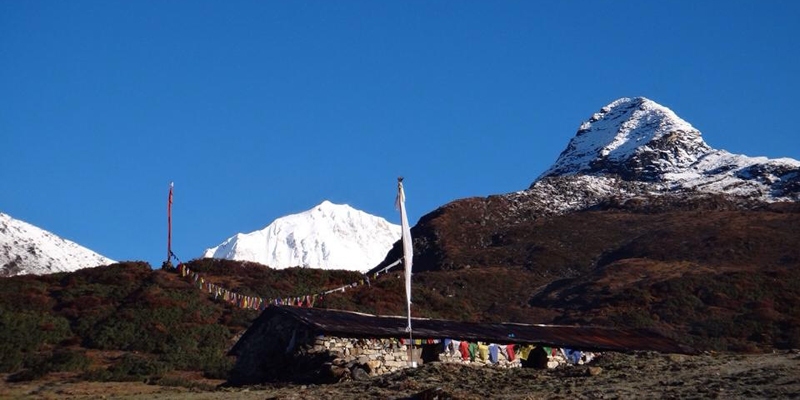
Goechala Trek
Destination
Sikkim
Trip Type
Trekking
Duration (in Days)
10
Altitude
4,940 m
Difficulty
Hard
Accommodation
Camping
Details
Goechala trek is the grand view of big mountains that you see. You don’t just see one summit — the Kanchenjunga — but 14 other big summits. That’s a lot for any trek — especially as close to the eyes as on the Goechala trek. It is no wonder that trekkers consider Goechala to be the closest to the big mountain treks of Nepal.
Sunrise on the Kanchenjunga Range
One of the biggest highlights of the Goechala trek is the sunrise, seen on the Kanchenjunga range. Even though trekkers are not allowed all the way to the actual Goecha Pass, the view from ViewPoint 1 and Dzongri is worth an arm and a leg!
Rhododendrons in March and April
The trail to Goechala is blessed with rhododendron forests. And come spring months of March and April, they burst to life with pink and red flowers! It’s an enormously pleasing walk through the wooden-log trails of these jungles!
The Samiti Lake
Samiti Lake is another big attraction on the Goechala trek. The view of the still waters, and the reflection of Mt Pandim in the lake, especially in the early hours, is a visual treat.
Trekking through the Kanchenjunga National Park, in one greenest region in the world, remains one of the top things to do for any holidaymaker in the Himalayas. Untouched by any affluence, these forests support a fine ecosystem, with numerous species of unusual flora and fauna. The weather remains clear during the winters and dramatic during the pre-monsoon season, with misty clouds playing around with your imagination. The whole Eco-system has maintained itself in harmony, as no singletree stands unaccompanied! The trek itself can be challenging in terms of distances to be covered in a day. One needs to get properly acclimatized as a huge altitude is gained in a small time during this trek, which is also another reason for its popularity. However, once you get walking it becomes easy to tackle the challenging distances.
The Goechala trek begins from Yuksom, a historical town in the West of Sikkim at the foothills of the Himalayas. Yuksom is a historical town in Geyzing subdivision of West Sikkim district in the Northeast Indian state of Sikkim. It was the first capital of Sikkim established in 1642 AD by Phuntsog Namgyal who was the first Chogyal (temporal and religious king) of Sikkim. The coronation site of the first monarch of Sikkim is known as the “Throne of Norbugang”. Yuksom is where there is the Norbugang Chorten near the Norbugang throne, the place Namgyal was crowned, and several monasteries and a lake. The dynastic rule of the Chogyals lasted for 333 years.
The Chogyal established the first monastery at Yuksom in Sikkim known as the Dubdi Monastery in 1701, which is part of the Buddhist religious pilgrimage circuit involving the Norbugang Chorten, Pemayangtse Monastery, the Rabdentse ruins, the Sanga Choeling Monastery, the Khecheopalri Lake, and the Tashiding Monastery.
For the Bhutia tribal community of Sikkim, Yuksom has special religious and cultural significance. It has a number of famous Buddhist monasteries and historical monuments. Being at the head of the Kanchenjunga National Park and as the base camp for trekking to Mt. Kangchenjunga, it has a large influx of mountaineers from all parts of the world. The village people, as stakeholders in biodiversity preservation of the Rathong Chu valley, where the village is situated, have played a significant role in trendsetting and promotion of Eco-tourism in the area. The inhabitants of this village have most successfully adopted the promotion of ecotourism not only in the region but also for other similar areas in Sikkim. Yuksom is thus considered a model village for Eco-tourism. With its unforgettable backdrop of the world’s 3rd highest peak, Kanchenjunga this trek attracts people from all over the world. It is also relatively less explored than Mt. Everest Base Camp and Annapurna. You will enter Kanchenjunga National Park and venture through pristine meadows and forests as well as crossing sacred lakes and incredible hanging glaciers. The 8-day Goechela trek allows you to be immersed in the mountains while seeing a panoramic view of the Kanchenjunga range.
Kanchenjunga, is the third highest mountain in the world and lies partly in Nepal and partly in Sikkim – India It rises with an elevation of 8,586 m (28,169 ft) in a section of the Himalayas called Kanchenjunga Himal that is limited in the west by the Tamur river in the north by the Lhonak the Chu and Jongsang La, and in the east by the Teesta River. Mount Kanchenjunga lies about 125 km (78 mi) east-south-east of Mount Everest. It is the second-highest mountain in the Himalayas. Three of the five peaks – Main, Central, and South – are on the border between North Sikkim and Nepal. Two peaks are in Nepal’s Taplejung District.
Kanchenjunga Main is the highest mountain in India and the easternmost of the mountains higher than 8,000 m (26,000 ft). It is called Five Treasures of Snow after its five high peaks and has always been worshipped by the people of Darjeeling and Sikkim.
Until 1852, Kanchenjunga was assumed to be the highest mountain in the world, but calculations based on various readings and measurements made by the Great Trigonometrical Survey of India in 1849 came to the conclusion that Mount Everest, known as Peak XV at the time, was the highest. Allowing for further verification of all calculations, it was officially announced in 1856 that Kanchenjunga is the third highest mountain in the world.
The area around Kanchenjunga is said to be home to a mountain deity, called Dzö-nga or “Kanchenjunga Demon”, a type of yeti or rakshasa. A British geological expedition in 1925 spotted a bipedal creature which they asked the locals about, who referred to it as the “Kanchenjunga Demon”.
For generations, there have been legends recounted by the inhabitants of the areas surrounding Mount Kanchenjunga, both in Sikkim and in Nepal, that there is a valley of immortality hidden on its slopes. These stories are well known to both the original inhabitants of the area, the Lepcha people, and those of the Tibetan Buddhist cultural tradition. In Tibet, this valley is known as Beyul. Demoshong. In 1962 a Tibetan Lama by the name of Tulshuk Lingpa led over 300 followers into the high snow slopes of Kanchenjunga to ‘open the way’ to Beyul Demoshong. The story of this expedition is recounted in the 2011 book A Step Away from Paradise.
Within the 10 days of Goehcala Trek, trekkers will enjoy the astounding view of Mt Khangchendzonga (8,586 m), Mt Kokthang (6,148 m), Mt Pandim (6,691 m) and several other peaks in the region. Isolated villages, high verdant, gleaming mountains blanketed in snow, misty clouds forming a canopy around magnolia and rhododendron forest and dramatic landscapes, makes Kanchenjunga BC Trek a perfect platform for trekkers. Book your seat now for this exciting trek.
Day 1
Darjeeling to Yuksom. Approx 6 hrs by car. Overnight Yuksom @ Hotel
Day 2
Trek Begins: Yuksom to Tsokha – 3050 m. (camping)
Day 3
Tshoka to Dzongri – 4320 m.- 6 hours (camping)
Day 4
Trek up to Dzongri-la 4500m (camping)
Day 5
Dzongri to Thangshing – 3800 m – 5 to 6 hours (camping)
Day 6
Thangshing to Lamuney (near Samiti Lake) – 4298m 3 to 4 hours (camping)
Day 7
Lamuney to Goechala (4,940 m.) and return to Thangsing 6 to 7 hours (camping)
Day 8
Thangsing to Tshoka – 3800 m- 7 to 8 hours (camping)
Day 9
Tshoka to Yuksam 6 to 7 hours. Trek ends. Overnight @ Hotel
Day 10
Yuksom to Darjeeling.
- Experienced English speaking guide.
- Transport to and from Darjeeling
- All necessary paperwork and permits in Mountain and National park (entrance and permit fees)
- Meals: Breakfast, Lunch, and Dinner
- Accommodation during the trek at guesthouse/lodge or family homestay
- Bed Tea
- Evening Tea
- Hot water for drinking
- Our guide will carry a comprehensive medical kit including high altitude sickness tablets
- Flights
- Medical examination (if required) and vaccination costs
- Visa costs
- Personal expenditure i.e. soft drinks/beer on the trek, extra snacks for the trek.
- Meals in Darjeeling before or after the trek Travel insurance











